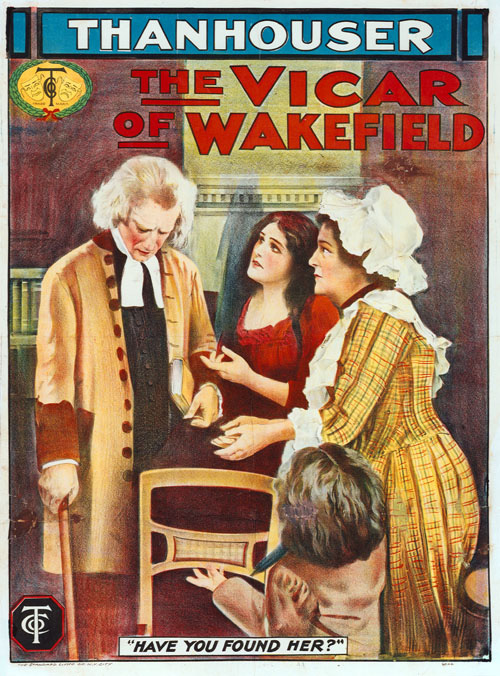 Volume II: Filmography
Volume II: Filmography Volume II: Filmography
Volume II: Filmography

Poster Image Courtesy Thanhouser Company Film Preservation, Inc.
December 27, 1910 (Tuesday)
Length: 1,000 feet
Character: Drama
Scenario: From the well-known novel by Oliver Goldsmith
Cast: Martin J. Faust (the Vicar of Wakefield), Frank H. Crane, Anna Rosemond, William Garwood, Marie Eline, Bertha Blanchard, Lucille Younge, William Russell
Notes: 1. Another film with the same title was released by Thanhouser in 1917. 2. A full-page illustration of a scene from the film appears in the editorial section of The Moving Picture World, December 10, 1910. 3. The German title of this film was Der Landprediger von Wakefield. A print with this title is preserved by the Library of Congress. 4. The Thanhouser emblem was used with abandon in this film and appears prominently on various interior walls (including a prison cell) and even on a tree in a picnic scene. This practice, common at the time with many film companies, was to minimize the possibility of unauthorized copies being made.
BACKGROUND OF THE SCENARIO: The Vicar of Wakefield, one of the most popular works of fiction in the English language, is from the pen of Oliver Goldsmith (whose biography is given under the entry for She Stoops to Conquer, a Thanhouser film released August 19, 1910). This landmark work, published in 1764, rescued Goldsmith from impending arrest for debt. The Vicar of Wakefield is difficult to categorize and is a complex story about the great priest (the Vicar), husband and father, Dr. Primrose, and the romantic escapades and near-marriages of his lovely children. The end is famous for its hilarious out-of-control double wedding and consequent "happily ever after" sentiment.
SYNOPSIS, The Moving Picture World, December 31, 1910:
"The Vicar of Wakefield, although a man of culture and learning, is a poor man of business. Despite the fact that he inherited a large fortune, he loses it through the dishonesty of others, and at the age of 50 we find him living in a humble cottage, fighting desperately to support his large family. At this juncture two strangers introduce themselves to the vicar. One is the young squire who owns the cottage in which the vicar lives, and the other, Sir William, the squire's uncle. Sir William, however, does not disclose his rank, but poses as a simple country gentleman. The squire becomes infatuated with the vicar's elder daughter, Olivia, and against the warnings of her father, she is induced to elope with him, the squire having arranged for a mock marriage.
"Later Olivia discovers how she has been tricked, and leaves the squire, who visits his wrath upon the entire family by having the vicar imprisoned for debt. Imprisoned, the vicar inspires the admiration and affection of all his fellow prisoners, to whom he teaches the comfort of religion. Among his converts is the squire's tool, who arranged for the wedding of Olivia and the squire. On learning that Olivia is the daughter of the Vicar, this fellow confesses that to play a trick on the squire, whom he really hates, he had furnished him a real minister, instead of a bogus one. The squire's uncle, Sir William, on learning the true state of affairs, forces the squire to ask Olivia's pardon on his knees, and the two are reunited. Sir William then discloses his identity and asks for the hand of Sophia. The vicar is released from prison, and he and his family look forward to a future of happiness and plenty."
REVIEW, The Moving Picture World, January 7, 1911:
"Another of those successful reproductions of literary masterpieces, which had been a feature by this house. The good old Vicar of Wakefield, Goldsmith's moving story, is here reproduced in all its kindliness. The characters seem to live before one, and all the pathos and beauty of the original is faithfully produced: the mock marriage of the daughter, the imprisonment for debt, the kindly offices among the prisoners, then, the discovery that the marriage was performed by a real minister, and the forcing of the young man to ask the girl's pardon, with reunion to follow, while the squire asks the hand of the older daughter. The picture closes with a glimpse of the happiness to which the good man is clearly entitled. As has been said before in this column, these reproductions of masterpieces are of benefit to everybody who sees them, while the presentation of such works is to be commended from every standpoint. They are well done, and to those who have read the stories, they come as illustrations of what they already know. If they have not read it, they are introduced to something which surpasses that to which they are accustomed."
REVIEW, The New York Dramatic Mirror, January 4, 1911:
"As adopted from the novel, this film shows how the vicar forbade the attentions of the young squire to his daughter, and the squire induced her to elope with him. A mock marriage was arranged. The girl soon learned of this from a drunken friend of the squire, and she left him. This so enraged that gentleman that he had the vicar sent to prison for debt. The squire's uncle, who seemed very young for his age, then learned of his nephew's escapade, and released the vicar from prison. It was learned from the rogue who arranged matters that the marriage had been real, and the two were brought together by the uncle. The production gave a very praiseworthy portrayal of the period, but a moving picture needs such different treatment from a novel that its interpretation in a picture is bound to lose much of the original interest. The acting was in every way adequate, although not great."
# # #
Copyright © 1995 Q. David Bowers. All Rights Reserved.